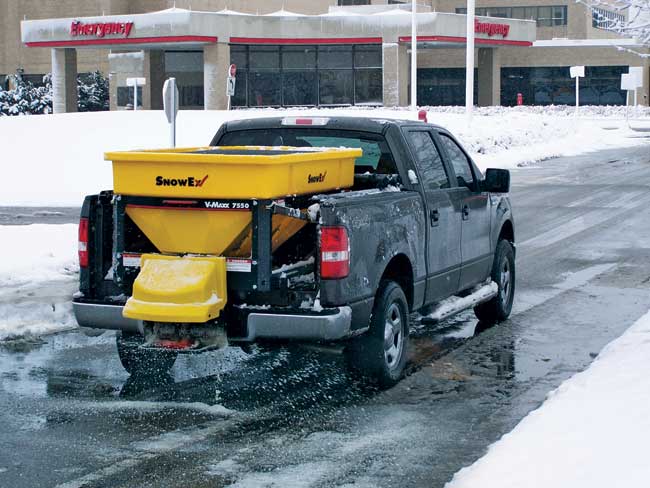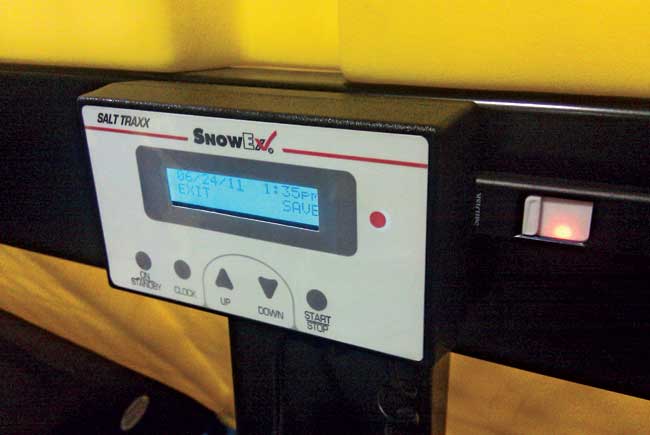Taking Care of Business
Most snow and ice contractors love learning about the latest equipment and practices within the industry, and every year they enthusiastically look forward to another winter. Of course, when you enjoy what you do for a living, it’s easy to get excited about new things that help you do the job better and make more money. What isn’t so easy is to get excited about is the accounting, billing and other paperwork that comes with the job.

Fortunately, there is new technology on the market that actually makes it cool to do your documentation, billing and overall business evaluation. The technology is available in products that electronically record important job data, which virtually eliminates the need to write anything down on paper. Recently, this trend has been taking off as contractors of all sizes are using it to literally start taking care of business.
The Need to Track
Although job-tracking technology is a relatively new concept to contractors, municipalities have actually been going high-tech for years. Besides the typical plows and spreaders, government fleets often equip themselves with GPS and a variety of instruments to measure the ground temperature, air temperature and other data to automatically adjust the salt flow according to conditions. This is done not only to reduce the amount of skill required to drive a municipal winter maintenance vehicle, but also to ensure streets and highways are kept as safe as possible for motorists.
On the other hand, most contractors don’t require such extensive technology when servicing their residential
or commercial lots, and the most advanced they typically get is to record jobsite data in a notebook. This usually involves writing down the date and time of each service, but some go as far as to note the air temperature and the estimated amount of material spread for each application.
However, the demand for contractors to track their jobs more accurately has grown. Clients continue to ask for more detailed information, and the nagging issue of slip-and-fall claims requires improved documentation as well. Thankfully, manufacturers have responded to this need by developing job-tracking solutions specifically for contractors. Rather than having all the bells and whistles of municipal gear, the new products instead track the information needed most for the private sector.
How It Works
At minimum, the job-tracking devices on the market record the date and time of each plowing or spreading application. This information is saved to pre-set job numbers, which are specifically set up for the various accounts handled by a contractor. This feature allows all data to be sorted according to client or lot. To use one of these devices, the driver first mounts the unit in the cab. Then he selects the appropriate pre-set job number when he arrives at a lot. To start and stop recording data, he appropriately pushes a start/stop button on the unit.
Besides simply tracking the date and time of each service, some devices have enhanced capabilities, such as calculating the amount of material spread. Until recently, contractors had no accurate method to determine this and, sadly, the most scientific technique was to eyeball the material levels in the hopper before and after an application.
In order to quantify the amount of material being spread, the job-tracking device must be designed to integrate with a spreader. For example, SnowEx’s Salt-Traxx digital job tracker works by plugging into the controller of a V-Maxx spreader, and the device constantly monitors the speed setting of the auger feed system. Once the operator has calibrated the system for a specific type of material, the unit can determine exactly how much of that material was spread on a lot according to the rotational speed of the auger and the time elapsed.
Oftentimes, job-tracking devices will also have the capability to save the data to a removable USB memory stick. This allows the contractor to easily upload all his information to a computer at the end of the day. From there, he can view the statistics in a spreadsheet, organized by date and job number. He’ll see the number of stops made on each job, the amount of time spent servicing the lots and, in some cases, exactly how much material was spread.
A Wealth of Information
The benefits of electronically tracking this data are many. For starters, contractors can save time going from one lot to another. They no longer need to pause to write down each instance a job is started or stopped. With an electronic device, they can simply press a button on the fly.
Next, job-tracking devices give contractors a better way to bill, since they now know the exact time spent servicing each account during the billing period. Not to mention, when clients ask for proof of service, the computer print-outs will appear much more professional than a coffee-stained notebook page filled with chicken scratches of vague information. The same information can also be used as evidence to reduce a contractor’s liability in the case of a slip-and-fall claim. By documenting that a lot was serviced in a timely manner, a contractor can prove he was not responsible for the incident. He can further reduce liability exposure if he uses a job tracker to document that a sufficient amount of deicing material was spread on a lot.
Furthermore, electronic job-tracking devices can help with overall business management. For example, if a contractor employs a couple of drivers, he can monitor the amount of time spent and material used on each route. This allows the contractor to correct issues if any of his drivers spend too much time or waste too much material on their jobs.

Additionally, by knowing exactly how much material is being spread on his lots, a contractor can more accurately estimate his salt purchases. This allows him to take better advantage of discounted salt prices at the beginning of the season. Finally, this type of technology also benefits contractors in an indirect way — by helping them sign new accounts. With job-tracking devices contractors have a new list of selling points when speaking with prospects. They can boast about the ability to provide detailed invoices and enhanced liability protection, and they may even be able to pass down the cost savings achieved by running their businesses more efficiently. Imagine the edge that a contractor can gain over competitors who don’t offer the same.
One Size Fits All
To the delight of many small contractors and one-man operations, it’s not just the biggest players in the industry who can benefit from the latest job-tracking technology. In fact, many of the products on the market are affordable for nearly any budget. However, the information gathered from the products may be used in different ways.
For example, large contractors are most likely to use electronic job trackers to help save money by ensuring their employees are working efficiently. By equipping an entire fleet with these products, contractors can measure the performance of each driver and keep a close eye on material usage. On the other hand, this benefit does not apply to one-man operations who understand their own performances first-hand. And other small contractors may not see as much of a need either, as they may already have a good grasp on the few employees and trucks they have.
However, small contractors who are experts in plowing snow and spreading material, but don’t know much about running a business, may benefit most greatly from a billing standpoint. While many large organizations may already have a software program in place for billing clients, most small contractors lack such a sophisticated system, so they see the biggest advantage in having detailed job information at their fingertips.
No matter the size of a contractor’s operation, he is likely to benefit from keeping track of his jobs electronically. And whether the goal is to improve billing, reduce liability exposure or simply save money, a job-tracking device can deliver by accurately recording important jobsite data on the fly. It’s not just a new type of product … it’s a whole other reason to get excited about winter.
James Truan is the vice president of sales and marketing at SnowEx, based in Madison Heights, Mich.
